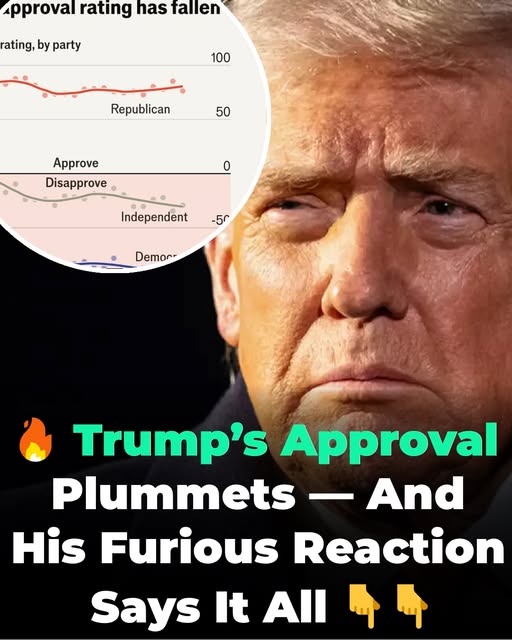Ten months into his presidency, former U.S. President Donald Trump found himself at the center of another political storm — this time, over new national polls that offered a sobering view of how the American public felt about his leadership. The data, released by multiple research organizations, suggested that Trump’s approval ratings had taken a sharp downturn, marking one of the lowest levels ever recorded for a modern U.S. president during the same period in office.
Trump, known for his fiery communication style and unrelenting confidence, did not take the results quietly. Within hours of the findings being made public, he issued a strong and defiant response across social media platforms, calling the polls “fake” and dismissing them as part of a broader effort to undermine his presidency.
“Fake polls! Same people, same numbers, same lies. The American people know the truth — we’re winning bigger than ever!” Trump wrote on X (formerly Twitter), shortly after the reports surfaced.
While his words fired up his loyal base, political analysts and observers said the data pointed to deeper challenges that could have long-term implications for both his political future and the Republican Party at large.
The Polls That Shook Washington
The new surveys, conducted by respected institutions including Gallup, Pew Research, and ABC News, revealed that Trump’s national approval rating had dropped to around 34%, with disapproval ratings hovering above 60%. Analysts noted that such figures represented a significant decline from his early months in office, when optimism about economic growth and deregulation efforts had initially buoyed public sentiment.
Among independent voters, the numbers were especially concerning for the Trump administration. According to aggregated data, only three in ten independents approved of the job he was doing, while nearly two-thirds expressed strong disapproval. This shift among centrist voters — who were critical in Trump’s 2016 electoral success — raised alarms among campaign strategists and party insiders.
“These numbers aren’t just low,” said political scientist Dr. Amelia Torres of Georgetown University. “They’re historically low for a first-term president, and they reflect growing dissatisfaction not only with policy but with tone and leadership style.”
At the same time, polls indicated that Trump retained overwhelming loyalty among core Republican voters, with approval ratings exceeding 80% within the party. That base remained his political lifeline, even as his broader appeal appeared to wane.
Inside the White House Reaction
Reports from insiders painted a vivid picture of tension within the White House following the poll release. Several staffers described Trump’s mood as “combative and frustrated.” According to one aide, he demanded detailed explanations about the methodology behind the surveys and instructed his communications team to publicly discredit them.
“He was furious,” the aide told reporters anonymously. “He said, ‘This is rigged. Totally fake. We need to fight back.’”
Advisers reportedly worked to craft a strategy that would shift public attention away from the negative headlines and toward what they framed as the administration’s successes — including economic growth, deregulation, and efforts to strengthen border security.
But some political observers said the president’s combative style often undermined those efforts. Instead of calming concerns, his public outbursts tended to amplify controversy and drive more intense media scrutiny.
“He doesn’t retreat — he attacks,” noted journalist Laura Jennings. “That approach energizes his base but alienates the middle ground.”
Public Opinion and Media Polarization
The controversy surrounding Trump’s approval ratings reignited debates about the reliability of political polling and the role of media coverage in shaping public perception. Trump and his supporters have long accused mainstream outlets of bias, claiming that negative coverage distorts reality.
Critics, however, argue that the polls accurately reflect a growing disconnect between Trump’s rhetoric and the broader electorate’s expectations.
“He thrives on conflict,” said political analyst Dr. Ian Roberts. “But constant confrontation — whether with the media, political rivals, or foreign leaders — eventually wears down public confidence. People want stability, not chaos.”
Meanwhile, Trump’s base rallied behind him online, echoing his claims that the polls were part of an orchestrated campaign by “Washington elites” and “fake news” organizations to discredit him. Supporters flooded social media with hashtags like #TrumpStillWinning and #FakePolls, emphasizing that the same pollsters had predicted his loss in 2016 — only for him to defy expectations.
Historical Context: Presidents and Polls
Historically, several presidents have faced low approval ratings during challenging periods. Harry Truman, Lyndon B. Johnson, and George W. Bush all experienced dips below 35% amid wars or economic crises. However, analysts noted that Trump’s numbers were unusually low for a first-term president still less than a year into his tenure.
According to Gallup’s Presidential Approval Index, Trump’s figures placed him below Barack Obama at the same point in office and slightly above Jimmy Carter’s lowest marks during inflation crises in the late 1970s.
“The difference,” said Dr. Torres, “is that Trump’s approval is polarized in a way we’ve rarely seen. His supporters are unwavering, but his detractors are equally entrenched. That creates a political stalemate where few opinions change.”
The Independent Voter Problem
Perhaps the most troubling sign for Trump’s political prospects was his slipping support among independent and suburban voters — groups that had played a decisive role in his 2016 victory.
A Reuters/Ipsos poll indicated that nearly 70% of suburban women disapproved of his handling of national issues, including healthcare and education. Similarly, a YouGov survey found that independents were growing weary of what they saw as “constant drama” in Washington.
“People want results, not reality TV,” one Republican strategist told reporters. “The challenge is that Trump’s communication style, while effective at grabbing attention, makes it harder to win over moderates.”
These trends could pose challenges not just for Trump personally but for GOP candidates running in competitive districts, where association with the former president remains a double-edged sword.
Trump’s Strategy: Turning Criticism into Fuel
Despite the bleak polling data, Trump’s team appeared determined to turn adversity into a rallying point. In speeches and online posts, the former president framed the new polls as part of a broader narrative of resistance — casting himself as the victim of an unfair political establishment.
“They’ve been lying since day one,” he declared at a rally in Ohio. “But we’ve beaten them before, and we’ll do it again. The people are with us — not the fake pollsters, not the fake news.”
The crowd erupted in cheers, echoing chants of “USA!” and “Drain the swamp!” For many supporters, Trump’s defiance reinforced their loyalty, transforming bad news into a symbol of resistance.
Political communication experts noted that Trump’s ability to redirect criticism into motivation for his base was one of his defining political skills.
“He turns weakness into strength,” said Dr. Roberts. “Where another politician might apologize or adjust, Trump doubles down — and that’s what keeps his followers engaged.”
The Broader Implications
The approval ratings saga carried implications far beyond Trump’s personal image. It underscored the growing divide within the U.S. political system, where partisanship often outweighed shared national priorities.
Pollsters observed a widening “trust gap” between political factions, with fewer Americans believing official data or media reports. This erosion of trust made it increasingly difficult to measure public opinion accurately or to build consensus on major policy issues.
“The polarization is real,” said data analyst Benjamin Crane. “People no longer interpret information the same way. For Trump’s supporters, bad polls confirm bias. For his critics, they confirm incompetence. There’s no common ground.”
Economic Factors and Public Sentiment
Beyond politics, some analysts pointed to economic anxiety as a contributing factor to Trump’s declining approval. While job numbers initially remained strong, inflation concerns and trade tensions had begun to worry consumers and investors alike.
A study by the Brookings Institution found that while GDP growth remained steady, wage stagnation and rising living costs were eroding confidence in the administration’s handling of the economy.
“People might like strong rhetoric, but their opinion ultimately depends on their wallet,” said economist Dr. Samuel Lee. “If everyday life feels more expensive, approval ratings drop — no matter who’s in charge.”
The Road Ahead
As Trump prepared for the months ahead, his advisers hinted at a shift in messaging designed to emphasize “strength, stability, and leadership.” Plans were reportedly underway for a series of rallies aimed at reenergizing his base while promoting economic progress and national security achievements.
“This is a president who thrives on challenges,” said one senior campaign official. “He sees every poll, every headline, as another battle to win.”
Still, political observers remained skeptical about whether those rallies could move the needle among undecided voters.
“You can rally your base all day long,” Laura Jennings observed, “but if you can’t expand it, you can’t win.”
Conclusion: A President in Defiance
As the dust settled, one thing was clear: Trump’s approval crisis was not just about numbers — it was about narrative. For supporters, the polls were proof of a biased establishment; for critics, they were a long-overdue reckoning.
Either way, Trump’s defiant response ensured that the story would not fade quietly.
“He’s fighting, and that’s what his people love,” Dr. Roberts concluded. “Whether it’s smart politics or not, it’s pure Trump — combative, relentless, and unwilling to back down.”
As the former president geared up for his next move, one question remained unanswered: Could defiance alone reverse the tide of public opinion?
Only time — and future polls — would tell.

